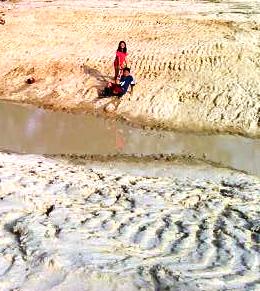Protected: Tabor Rotation Planning Guide Samples
Meaningful Math & Meaningful Management!
Fun isn’t always educational and education isn’t always fun, but when the two come together – it just doesn’t get any better.” -Tom Jackson
“Research consistently shows that the more time students spend involved in learning activities, the more they learn. That is, there is a strong positive relationship between the amount of time students are actively engaged in learning activities and their achievement. Further, increased time spent in academic learning does not result in negative attitudes toward school or learning.” -afcec.org
“The more engaged my students are the better they behave. When they buy into the system, they make it work.” -Debra L. Epstein
In this season of testing, some of the focus should really be on the amazing results seen by teachers who have worked hard all year to help their students meet and exceed their potential. Here is the story of one teacher’s journey to do just that!
You learned how to use The Tabor Rotation Framework to sophisticate the differentiation of math instruction in your school. How has this impacted you and your teaching?
Being trained in Tabor Rotation has been a wonderful experience. It took a lot of things I already did teaching math and gave me a framework to organize these strategies and so much more. It has made me more focused in my teaching of math.
Now, as I plan, I incorporate the most challenging concepts in Teacher Time and use Whole Group Time for easier concepts. The Manipulatives Station, on Rotation Days, gives my students a chance to explore and I truly feel like a facilitator. There is only so much time in the math block and now everything I use is done purposely.
What about your students? What do they think about Tabor Rotation?
My students love it! Today, during writing, we were doing self-selected persuasive pieces. One student asked me to check his work. When I read his topic, I laughed,
“We should have Tabor Rotation every day!”
The students love this way of learning mathematical concepts. They love being leaders and co-leaders. And, they especially love Teacher Time! It is their chance to shine with more individualized attention from their teacher–they love it when I do “fifth grade” stuff!
What have been the challenges of using a framework like Tabor Rotation? How did you address these challenges?
The biggest challenge of using this framework is time. It takes time to do small-group, differentiated instruction well and planning time is already packed. It also takes time to find resources for the rotation stations and time to prepare them. Planning with our Staff Development Teacher during our bi-weekly planning time has been very helpful. She gathers a lot of resources for us and helps us focus and prioritize as we plan.
Another challenge was sophisticating my classroom management. In one teleconference session with Glenna, I learned about a free classroom management tool on her website. It’s designed to teach students life skills, personal accountability, and math skills-all at the same time. I decided to try it.
What is the power of Meaningful Math Management?
Meaningful Math Management rocks! Students need some sort of true motivation to want to learn and Meaningful Math Management provides that. My well-behaved students were getting frustrated by their classmates’ misbehavior. Now, I have an easy way to reinforce good behavior-money! They love it! My students determine, through self-assessment, what they earn as the day progresses. They want to earn money and they will do such wonderful things to earn it! They share supplies. They help each other more. They ask for EXTRA homework. They do EXTRA class work. They stay more focused and work harder, among many other things. They are more motivated to behave as a result of the system and are better prepared due to more homework completion.
What would you say to a teacher who is considering using Meaningful Math Management?
I would tell them that it may seem like a lot of work sometimes, but it is well worth your efforts! You may have to figure out how to make it best fit in your classroom and that might be a little different for everyone. One of my colleagues uses it a little differently, but the results are the same.
I would also tell them that the preparation is worth it because they will see a huge improvement in their classroom. With Tabor Rotation and Meaningful Math Management, my students are finally mastering the concepts! On the last assessment, my students’ performance had increased over 40% from the previous assessment. Meaningful Math Management is a great motivator for all students- the well behaved ones and the at-promise ones. Your students will be more aware of their own behavior and work harder for you and themselves. They will be more motivated to be respectful and responsible.
Of all the changes you’ve made this year, which one do you think is most important and why?
Of all the changes I’ve made this year, the most important one has been empowering my students more. Through the frameworks of Meaningful Math Management and Tabor Rotation, I have let go of the reins and empowered my students to be active learners. I facilitate more. I provide them lessons in whole group and teacher time- but they get to put them into practice during rotations. I give them a framework and guidelines to earn money, but they decide what they have earned and how to spend it.
My students now make choices and deal with the consequences and rewards. As one of my students wrote when we last reflected,
“It gives students more responsibility.”
Another shared,
“I would tell Ms. Tabor that I enjoy being responsible for my own money.”
To sum it up, one student in my class said it perfectly, she wrote,
“Math Management helps me be a better students because it has helped me decide to work hard and push myself to the limit. It has also helped me want to help other students.”
Wow, now those amazing results will last a lifetime!
“Tell me and I forget. Teach me and I remember. Involve me and I learn.” – Benjamin Franklin
“If a doctor, lawyer, or dentist had 40 people in his office at one time, all of whom had different needs, and some of whom didn’t want to be there and were causing trouble, and the doctor, lawyer, or dentist, without assistance, had to treat them all with professional excellence for nine months, then he might have some conception of the classroom teacher’s job.” -Donald D. Quinn
Read student comments about Meaningful Math Management and download Meaningful Math Management and all its components from the FREE RESOURCES page of www.glennatabor.com.
Here are some links to more resources on effective classroom management and engagement:
“Beyond Classroom Management to Intellectual Engagement”
“The Critical Role of Classroom Management”
Fractions: Fun or Fungal?

I began writing this blog post after receiving an email from a teacher who wanted a copy of several of the games I used during a demonstration lesson involving fractional concepts. Not wanting to just give her “fish” I thought about how to give her more. Since receiving that email, I have rewritten the rough draft of this post many, many times. The first version of this blog post was way too long and I was pretty sure no one would read all of it. The second version was too short and would have only skimmed the surface.
Hopefully, this post is “just right.” I’ve included highlights from the research and support for the concrete development of fractional concepts, examples of concrete explorations of challenging fractional concepts, and games to make learning fractions fun.
“Clearly, the way fractions are taught must be improved. Because of the complexity of fraction concepts, more time should be allocated in the curriculum for developing students’ understanding of fractions. But just more time is not sufficient to improve understanding; the emphasis of instruction should also shift from the development of algorithms for performing operations on fractions to the development of a quantitative understanding of fractions.” -Bezuk and Cramer
The above quote is from “Teaching about Fractions: What, When, and How?” by Nadine Bezuk and Kathleen Cramer. They wrote about the need for our schools to teach fractional concepts differently. They “encourage teachers to use an instructional approach that emphasizes student involvement, the use of manipulatives, and the development of understanding before beginning work with formal symbols and operations.”
Bezuk and Cramer make the following general recommendations for the teaching of fractions:
- The use of manipulatives is crucial in developing students’ understanding of fraction ideas. Manipulatives help students construct mental referents that enable them to perform fraction tasks meaningfully. Therefore, manipulatives should be used at each grade level to introduce all components of the curriculum on fractions.
- The proper development of concepts and relationships among fractions is essential if students are to perform and understand operations on fractions. The majority of instructional time before grade 6 should be devoted to developing these important notions.
- Operations on fractions should be delayed until concepts and the ideas of the order and equivalence of fractions are firmly established. Delaying work with operations will allow the necessary time for work on concepts.
- The size of denominators used in computational exercises should be limited to the numbers 12 and below.
Their article contains a gold mine of useful strategies and the reasoning for the use of these strategies. It would be worthy of your time to read more.
http://www.cehd.umn.edu/rationalnumberproject/89_1.html
One of the most challenging fractional concepts for me was fractional parts of a number. I knew the algorithmic procedure for finding the answer, but I was always the student who wanted to know “why” not just how. After having concrete experiences with fractions in my math methods course in college, I determined to always use these kinds of concrete experiences with my students. The following activity, perfect for the Teacher Time Station of The Tabor Rotation Framework, is amazing to watch and highly successful with students!
Each pair of students is given a set of miniature shirts cut out of fabric and a bag of interesting buttons. First, the students explore fractional parts of a set by pulling out two different kinds of shirts for a total of 4 shirts. The teacher asks students to talk about their sets in fractional language. An example of a student response might be, “I have 2 red bandana shirts and 2 red plaid shirts. That means that 2/4 of my shirts are red plaid. If I separate the shirts like this you can also see that 2/4 is equivalent to 1/2 because it’s obvious that 1/2 of my shirts are red plaid and 1/2 are red bandana.”
Next, the teacher asks the pairs of students to select 12 buttons from their bags and arrange them in equal numbers of buttons on the shirts. The students are asked to talk about their buttons in the same way they talked about their shirts. After a few variations on numbers of shirts and number of buttons, the teacher encourages the students to read the following question with their partner and determine the answer. “What is 1/4 of 12? How do you know?”
Almost every single student will look up and around and start trying to “think” about how to answer the question. The teacher should suggest that they look down and use the shirts and buttons to help them answer the question.
It won’t take long for one of the students to push a shirt up and say, “It’s 3!” The explanation of “how they know that” might be, “We pushed up 1/4 of the shirts to show 1/4, so wouldn’t 1/4 of the 12 buttons be on the same 1/4 shirt?”
The lesson continues with different numbers of shirts, different numbers of buttons, and deepening understanding of fractional parts of a set and number. The teacher may write the abstract representation for what the students are doing concretely, but that is not the emphasis of the lesson.
Since we know the brain learns best concrete-to pictorial-to abstract, the following technology can be used to bridge the conceptual development from the concrete buttons and shirts to the pictorial. The following week a teacher might put a highly interactive app, like Educreations, (http://itunes.apple.com/us/app/educreations-interactive-whiteboard/id478617061?mt=8) in the Application/Technology Station of the Tabor Rotation.
The students are instructed to “teach another student, in another state, about fractional parts of a set and number using the interactive white board.” This lesson is posted online and can be viewed by the entire class. It can also be used as a performance-based assessment. The following link is an example of one explanation of fractional parts of a set and a number.
http://www.educreations.com/lesson/embed/562151/?ref=app
If you have fraction bars and want to help your students explore fractional parts of a whole, equivalency of fractions, and readiness for addition/subtraction of fractions with like denominators, then the following games would be extremely useful.
Fraction Flip, Make Mine Whole, Equivalent Concentration
If you’d like to continue your exploration of fractions, then you may want to visit the following sites.
NSA has a 32-page booklet full of pre-assessments, activities, games and really engaging fraction lessons.
http://www.nsa.gov/academia/_files/collected_learning/elementary/fractions/What_Fraction_am_I.pdf
Kids R Kings Katering is a performance-based assessment task developed by Mary Benton and Renee Patrick. This real-world application of fractions and decimals would be an incredible experience and connection-making tool for 5th-7th graders.
http://www.nsa.gov/academia/_files/collected_learning/elementary/fractions/kids_r_kings_katering.pdf
To learn more about possible challenges to a student’s understanding of fractions, read this practice guide from the U. S. Department of Education. It includes actual student examples, recommendations, and “roadblocks” with ways to get around these roadblocks.
http://ies.ed.gov/ncee/wwc/pdf/practice_guides/fractions_pg_093010.pdf#page=25
Why use the activities and games in this blog? Why do research to become more effective in your instruction of fractions? If a shirt and a bag of buttons could change a student’s mathematical high school career, wouldn’t it be worth it?
“We shall not cease from exploration and the end of all our exploring will be to arrive where we started and know the place for the first time.” — T.S. Eliot, Four Quartets
Objective Observation
“The cure for boredom is curiosity. There is no cure for curiosity.” -Dorothy Parker

One of the most powerful tools a teacher has available is objective observation. In a differentiated math classroom, especially one that makes use of math stations, observation is essential. I was reminded of this in a conversation with an administrator who had hired me to assist her school in the sophisticating the ways in which they instruct mathematics.
I asked her to look at the 14 Essential Elements of The Tabor Rotation Framework and identify the ones that were most important for her teachers to learn. I indicated that these would be the Essential Elements that would be emphasized in their upcoming training days. After reviewing the list for a couple of minutes she put an asterisk next to several of the Essential Elements. Two of the ones she noted were “Heterogeneous and Homogeneous Grouping of Students” and “Tiered Instruction.”
After noting those elements as most important, she realized that in order for her teachers to form homogeneous or readiness groups and tier the instruction they would have to begin with Pre-Assessment (another Essential Element of Tabor Math) and continue their observation and progress monitoring through Clipboard Cruising. I showed her one of the spreadsheets recently modified by one of the schools who uses Tabor Rotation. This spreadsheet provides for the recording of any assessment results, observations during direct instruction, and teacher notes. It also includes a place for immediate formation of Readiness Groups for Days 4 & 5 of Tabor Rotation.
There is power in objective observation, but it is sometimes very challenging for teachers to remain objective, process observers. The writings of John C. Harrison share The Power of Observation. He says,
“All personal change begins with observation.
But a particular kind of observation.
If we keep looking at our experiences through a familiar window, the same familiar sights and truths are going to keep surfacing. The “window” through which we see the problem has a powerful influence in shaping our perception. For example, a starving man will look at a restaurant menu a lot differently than someone who has just finished off a six course dinner. A local meteorologist will notice different things about a Hawaiian sunset than a painter on holiday. And a psychiatric social worker will perceive a convicted felon in a different light than an assistant district attorney or the warden of the local prison.
To a substantial degree, what is important to the individual and what he or she expects to see has an enormous impact on what he or she actually observes.
The challenge, then, is to learn to observe objectively.”
If your students are to “move a little bit further than they were the day before” then we have to approach our instructional pedagogy as if our students were starving for knowledge and we have to quickly, efficiently, and qualitatively challenge them every single day. Can you imagine the power in our schools and in our students if every single teacher did just that for the rest of a student’s life?
I know this administrator wants what is best for her school. As she continued her review and gradation of the 14 Essential Elements she chuckled to herself, looked up at me, and said,
“That’s why you called these essential…my teachers need to understand and do all of these things. You can’t teach math effectively by doing half of them. I want you to emphasize every single one.”
Tap into your own power…download this Observation Sheet with Grouping…clip it to a board…observe…then use the information to change students’ lives!
Math Apps Students (and their Teachers) LOVE!
“Do you use IPads in the Technology/Application Station of Tabor Rotation?”
“What apps do you recommend?”
“Could I write a grant to get more technology in my classroom?”
These questions are frequently asked by Tabor Rotation teachers in math and science, since one of the Tabor Rotation Stations is the Technology/Application Station. It’s also being asked by parents who are looking for ways to help their children learn, have fun, and use their newest technology—all at the same time. My next few blog posts will feature the apps that have received the greatest reviews from my students.
The first app I introduced to in my Technology/Application Station is called Math Bingo. This app caught my attention immediately because so many students need practice in computation, but don’t want to use flashcards and timed worksheets to improve their basic skills.
The object of Math Bingo is to get a pattern of five Bingo Bugs in a row by correctly answering math problems. You can choose 4 games: Addition, Subtraction, Multiplication, and Division at three different levels: Easy, Medium, and Hard. Level 1.4 Math Bingo features a mixed Bingo game. Because this game is at varied levels and varied or mixed operations, I am able to use it with students from 1st to 8th grade.

Math Bingo is immediately rewarding and self-checking. Players get Bingo Bugs if they make a high score. A bonus to teachers is the ability to view high scores by individual players, track the items missed, and the amount of time it took the player to solve the problems. If your students are addicted to the app, Angry Birds, then they’ll really enjoy the Bingo Bug Bungee which is similar to Angry Birds.
I have to say that Math Bingo is not only effective, but it is addictive—even for adults. This app from ABCya.com is well worth the .99 I paid for it. The current version, for IPods, IPads, and IPhones, has received almost 2,000 ratings with over 4 stars. My students and my own children give it a HUGE thumbs up!
Math Ninjas, by Razeware.com is the current favorite app of all of the students because it is the most like an arcade game. Players “use math skills to defend their treehouse against a hungry tomato and his robotic army.” The game is so highly interactive that it kept the attention, and engaged my most reluctant learners. In fact, my students liked it so much that I became suspicious of the math portion of the app and ended up playing it right along with them for over 30 minutes. (Okay, I could have stopped after ten minutes, but it really is addictive!) The computational operations selected at the beginning of the game aren’t just a side note, but are needed because it’s the only way the player can progress and move to the next level.
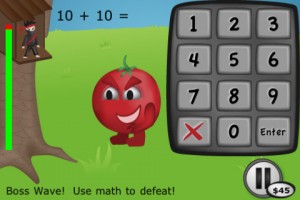
You can download the free version of Math Ninjas, but my students quickly reached the top levels of the free version and begged me to spend $1.99 for the full version. It was worth it! I agree with the 403 reviewers who gave it 4 stars—this app doesn’t skimp on learning or fun!!!
The last app I write about today may not have the flashiest graphics, but it is my favorite of these three. It’s a teacher favorite because it gave me a new, different, and highly effective way to help my students who have continually struggled with complex questions about number lines.
Math Tappers: Numberline is a FREE app that “challenges players to find the locations of numbers on a number line.” What was fascinating to watch was the development of my students’ proportional reasoning skills while playing the game. I’ve never had students want to practice this skill, but mine were incredibly disappointed when the Station Rotation time was up. Math Tappers also has other free math apps for telling time, elapsed time, estimating fractions, multiples, probability, and using base 10 blocks. The Math Tappers motto is “Play, Explore, Understand! This app did just that for every one of my students who used it. Bonus? The students were asking if they could play the Number Line app during their self-selection time—what more could you ask for?

And, now to answer that last question, “Can I write a grant to get more technology in my classroom?” If you use documentation like this blog to support your use of it–YES!
What can you hear in your room?
“There is no such thing as a worthless conversation, provided you know what to listen for. And questions are the breath of life for a conversation.” -James Nathan Miller

“You were the first person to stop talking at me and give me something I could move in Algebra. Today was the first day I understood—really understood what I was doing.” -Algebra student exploring polynomials in the Manipulative Station
The previous statement made me think about conversations that encourage, build, and are productive in an educational setting. These types of conversations are vital in a math classroom. While working with schools over the last month, I decided to listen closely in classes who use Tabor Rotation. Here are a few of the things I overheard.
“I want you to work with a partner reviewing your vocabulary cards for the next 3 minutes. After you’ve worked with your partner, we’re going to play a game to help you remember your words.”
I saw partners working together, in this classroom, during the warm-up described above and during the Whole-Group Mini-Lesson. During the whole-group lesson, the teacher would instruct for about five minutes, then give the partners a chance to explain what they were thinking to each other or solve a problem together. 100% of students were on-task and engaged.
“One of the teachers in our cluster has developed an observation chart for the coming unit so we’ll be able to better determine each student’s depth of understanding for the important concepts. This will also help us form readiness groups.”
This type of statement from a faculty is amazing and speaks to the high level of professionalism at this school. Not only did these teachers plan for pre-assessment, give the pre-assessment, use the pre-assessment for planning their unit of study, but then they planned for consistent and meaningful on-going assessment. They truly believe in teaching what is needed only to those who need it.
“You have a Menu of Options for the rest of the week. The materials you need are in the buckets with the corresponding number on the menu. If you have any questions, please see the leader or co-leader of your team.”
After the teacher briefly reviewed the tiered Application Menu of Options for Days 4 & 5 of Tabor Rotation, the students immediately made their choice and went to the correct location for their materials. The materials were in numbered buckets and were also color-coded for easy identification. This grade level was well organized in the independent/partner work so they could meet with more readiness groups formed to meet specific needs of students.
“You have your chapter quiz on your desk. While you are working the co-teacher and I may pull you for a few minutes to work with you at your level. You’ll have plenty of time to finish the quiz and go on to Anchoring Activities.”
What a wise use of time during a short quiz and while a co-teacher was in the room. The sound level in the room never rose above a whisper and there wasn’t a minute of wasted time in the classroom. Both teachers were working with small groups and said that planning together for their readiness groups made the difference to the students.
“Materials Managers, please collect the geometry foldables that were used as reference during the test.”
This is an example of a Tabor Rotation teacher sponging up every spare minute. He taught until three minutes before the bell rang, but had plenty of time for clean up because every student in the class has an active role in the classroom and knows how to do their job. Before the bell rang, the classroom was back in order and the students were practicing simultaneous interaction by sharing what they learned that day with a partner.
“I can’t figure this out…but if you’ll explain it to me again, I might get it!”
This statement was made by a student who was playing a game with her team. The teacher had given an overview of the rules to the entire class and the team leader had explained the rules, but the student still didn’t understand. It said volumes about the atmosphere established in this classroom that a student would feel comfortable sharing this with her team. Being actively engaged with a team gave this student the medium for this type of discussion.
“I know you’re up there in your ability with these concepts, so I want you to try the top line of the Application Menu of Options. You can do it!”
A truly differentiated classroom is guided by a teacher who has anticipated different levels of understanding of the concepts for the week and has prepared for that difference. The Application Menu of Options in this class had on-level activities, approaching level activities, and above-level activities. The teacher was circulating in between readiness groups when he made this statement to a student who was hard at work. He was qualitatively challenging this student at her level of understanding.
“We’d really like to thank one of our teachers for developing real-world activities for the concepts. It really helps us teach difficult concepts to students when they have a connection.”
If the brain learns best when it makes a connection to the information, how do you do this when teaching complex, higher-level concepts? This faculty knows how important it is for the student to make a real-world connection and spent time, before the unit began, developing real-world activities that would help the students make connections to the concepts. So many adults wish they had this type of instruction in high school. These teachers are ensuring that their students have a deep understanding of the concepts and know why they’re learning them!
“The first table ready for rotations earns $10. If every table is ready when the timer goes off, then every table wins.”
This teacher is using extrinsic motivation to encourage his students to transition into the new class period and be ready for the rotations to the four stations that will explore the week’s concepts. The activities at the stations were engaging and the teacher used both intrinsic/engaging and extrinsic/rewarding methods to make the most of his mathematical minutes.
What can be overheard in your classroom? Does the conversation reflect that you are trying to move every student just a little bit further than they were the day before? Hope so…
“Anyone who thinks the art of conversation is dead ought to tell a child to go to bed.” -Robert C. Gallagher
“No man ever listened himself out of a job.” -Calvin Coolidge
“Listen. Do not have an opinion while you listen because frankly, your opinion doesn’t hold much water outside your universe. Just listen. Listen until their brain has been twisted like a dripping towel and what they have to say is all over the floor.” -Hugh Elliott
The Power of Teacher Observation
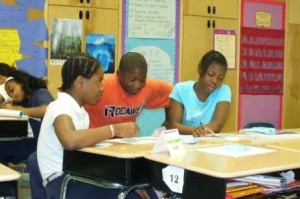
Maria Montessori says, “We cannot create observers by saying “observe,” but by giving them the power and the means for this observation.” I cannot agree more and that is why Clipboard Cruising is one of the 14 Essential Elements of the Tabor Rotation Framework. Clipboard Cruising, or constant and consistent teacher observation is complimented by two other Essential Elements of Tabor Rotation, Exit Questions and Math Journal Writing. All three are a part of the on-going assessment and feedback process in the Tabor Rotation Framework and are essential elements in ANY classroom.
As teachers move along on the continuum of effective implementation of Tabor Rotation, they begin asking these kinds of questions:
“I’d like to learn how to better target my instruction for each level of student in my classroom.”
“I wish I had a systematic but simple way to measure and monitor the growth of all of my students—even if I have over 120 of them!”
“How do I teach everything I need to teach in my subject and my level when some of my students don’t have the prerequisite skills?”
“Can’t you put your observation sheet into a spreadsheet format so it’s easier to modify and record on?”
The fact that so many teachers have emailed me with these requests amazes me. A teacher who asks these kinds of questions is truly being a reflective practitioner and assessor of the effectiveness of their own instructional practices. I think Yogi Berra summed it up well, “You can see a lot just by observing.”
Below are some helpful hints as you fine tune the observational process with your students:
1. Simplify the process so you can form and use readiness groups.
Remember, readiness groups are the flexible groupings of students who meet with a teacher based upon their level of understanding of the concepts and skills being explored. Homogeneous groups are part of Days 4 & 5 of the Tabor Rotation Framework and are necessary is a teacher is meeting the needs of all students—no matter their level of understanding. One way to simplify the process is to get a clipboard for every class you teach.
2. Pick the tools that will make you want to pick them up and use them.
I always choose clipboards that are colorful. I also select pens which are my favorite writing tools. It may sound crazy, but I tend to go Clipboard Cruising more when I write with a metallic gel pen than if I were writing with a plain, fine-point pen. Using my favorite tools makes me smile.
Start off your observations by simply noting at least 3-5 behaviors in a day. Gradually increase to 10 behaviors. Then move to observing groups or students.
3. Only observe what cannot be assessed more easily using some kind of paper-and-pencil tasks.
An example of this is when a teacher completes a direct instruction in a Whole-Group Mini Lesson and asks the students to work 2-3 problems that apply the skill they’ve just learned. The exit cards are handed to the teacher as the students leave the room and give the teacher immediate feedback on the level of understanding of the students.
This information could then be used, by the teacher, to form an approaching-level readiness group the next day. He might meet with this whisper group during the warm-up or bell work time. Based upon the exit card responses, the teacher notes that 4 of the students in a class are making the same error in procedure. He knows that if he shapes this procedural knowledge before it’s internalized, then his students will learn the skill and the concept attached to it with correct automaticity.
3. Target the big ideas of the chapter or unit of study that all students MUST HAVE in order to be successful in their conceptual development in the subject matter.
A teacher who tries to observe everything tends to be quickly overwhelmed. Targeting big ideas, instead of every single skill or concept in a unit of study, allows you to conduct consistent observations of the depth of understanding for what’s most important.
5. Give a short quiz at the end of a class period and circulate to observe your students as they are working.
Not only will this be a check for understanding and a form of on-going assessment, but it will give you the chance to circulate and ask specific students questions about the procedures they are using to work a problem. This short quiz could also be used for a daily grade.
6. Focus on observing the students you meet with during small-group, guided instruction or Teacher Time and in Readiness Groups before trying to observe the entire class.
Just narrowing the number of students you’re observing makes it more likely that you will be able to conduct regular observations. The information you gather about your students in Teacher Time is invaluable. This is the time, in The Tabor Rotation Framework, when teachers meet with ¼ of the class at a time to instruct the most difficult concepts for the week.
You can note what strategy students use, the challenges they are facing, or the high level of understanding and application of the concept they already have. Remember, observation is done with all students–not just the ones who are struggling. All students deserve to be respectfully and meaningfully engaged with qualitatively challenging work that is at their instructional level.
7. Select 4-5 students a class to observe instead of trying to observe everyone.
Some teachers divide their class into quadrants and observe a specific section each day. Some teachers decide to observe one row in their classroom. When you narrow the number of students to observe, then you’ll be more likely to accomplish your observational goals.
8. Schedule observations into your daily routine.
The age-old teacher saying is true. If you fail to plan for observations, then you’ll fail to conduct observations. Write it into your daily and weekly lesson plans so that you know when you should stop instructing and start observing.
9. Resist the temptation to stop and “fix it.”
One of the greatest challenges, when teachers begin to rigorously and systematically observe students, is resisting the temptation to stop and fix an error a student is making. If the adjustment or instruction is going to take over two minutes, then you probably need to meet with them in a readiness group instead of during clipboard cruising. If you’re regularly assessing, observing, and using this information to form readiness groups, then you know that you’ll be working with those students the next day.
10. When it comes to on-going assessment, observations, and clipboard cruising, keep this Nike mantra in mind…JUST DO IT!
Try using these observation recording sheets to help you get started. Good luck!
Spreadsheet for Observations & On-Going Assessment
“Opportunities are often things you haven’t noticed the first time around.” -Catherine Deneuve
Texas Drought Benefits Math Concepts
“We don’t stop playing because we grow old; we grow old because we stop playing.” -George Bernard Shaw
The Texas drought may have dried up our pond, but it offered our two youngest children the opportunity to play in the biggest mud puddle they’d ever seen. I told them they could play in the mud puddle as long as they wore their boots and didn’t get too messy. All moms reading this blog are chuckling to themselves…you know that it wasn’t five minutes before the first child went in past the top of their boot. At that point, I quit worrying about the muddy mess and decided to make it into muddy math.

“It is paradoxical that many educators and parents still differentiate between a time for learning and a time for play without seeing the vital connection between them.” -Leo Buscaglia
I talk to teachers and parents about simple ways to develop mathematical concepts in every situation. I emphasize that the greatest tool they have is their ability to ask questions, make a real-world connection, and engage their children and students in math that’s FUN. The following list is comprised of what might have caused parental alarm and a negative parental response, but was transformed into meaningful math conceptual development.
1. The children tried to go all the way across the pond without their water going into their boot.
If your boot is 12’’ tall, how deep do you think the water is?
2. Both of the children don’t make it across the pond and are standing in water that is pouring into their boot.
Since there’s water pouring into your boot, use what you know about the height of your boot and the height of the water on your leg to estimate how deep the water is. Use this same information to see how much deeper the water is at different locations in the pond.
3. One of them stands in the middle of the pond too long and his boot is stuck. He’s about to fall over—especially when he starts laughing because his foot came out of his boot.
How deep do you think the mud is? Compare that depth to the depth of the water. Where do you think the mud is the deepest? Why?
4. Both children can barely make it out of the water because there is so much water in their boots.
How much water is in your boot? What is the type of measurement you are making when you estimate the amount of liquid something can hold?
5. Now that their boots are completely wet and most of their clothes are wet they decide to complete the drenching of their clothing by racing each other across the pond.
How fast can you run across the pond? Do you think you can run as quickly with your boots full of water? Why or why not? Try it and see if you’re right.
6. Since they’ve begun to run across the pond laughing, the inevitable is going to happen….complete immersion.
How long will it take before someone falls in?
7. After immersion of at least one child, they sit on the side of the pond to wring out their clothes and dump their boots for the hundredth time.
Did filling your boots with water and drenching your clothing make a difference in the amount of water left in the pond? Why not? How could you measure the amount of water in the pond?
8. While they dump their boots they notice that the water is flowing down certain portions of the bank faster.
How many seconds does it take for water to go from the top of the hill to the giant puddle? Which goes faster—crevasse or flat surface? What is that called?
9. They’ve grown tired of running across the pond and are taking turns pouring water out of their boots down the hill.
What is the difference between kinetic and potential energy? What does the pond represent? What does the pouring of the pond water represent?
10. The language of science appeals to my daughter who knows that math and science go together and that both are everywhere and in everything.
How many different things can you see near the pond that have potential energy? Kinetic energy? (Their favorite form of kinetic energy is themselves running down the hill. Their favorite form of potential energy is stopping just short of falling in the pond…of course, one of them does happen to fall in.)
11. One of them comes up to me and shows me how wet they are and how little water and mud is stuck to their hair.
I ask them, “What is a good probability word that describes the likelihood of you having to take a shower? What is the percentage chance of you having to use soap?”
As we trudge back up the hill and away from the pond we pass an armadillo digging in the dirt. We decide that the likelihood of the armadillo taking a shower is never and we sit down in the dirt to watch him finish his hole. The experience had brought all of us a little mud, a little math, and a LOT of fun!
“You can discover more about a person in an hour of play than in a year of conversation.” -Plato
“It’s the GREAT Pumpkin, Charlie Brown!”
“I’ve learned there are three things you don’t discuss with people: religion, politics and the Great Pumpkin.” -Linus
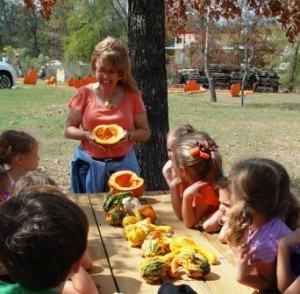
Out of all of the Peanuts comic strips and television specials, this one is my favorite. As a child I thought that waiting for the Great Pumpkin was much more fun than waiting for Santa Claus.
As a teacher, my grade level was never the one who went to the local pumpkin patch to pick pumpkins. So, when a friend told me he ran a pumpkin patch in Delaware (Yes, that’s where Pumpkin Chunkin’ is an art form and big competition.) I quickly volunteered to be the Pumpkin School Teacher.
This one time adventure turned into six years of incredible experiences teaching over 4,000 students a year all about pumpkins. I have researched the life cycle of pumpkins, types of pumpkins, the history of pumpkins, pumpkin contests, pumpkin decorations, and pumpkin recipes. I have tried every pumpkin and every recipe I could find–just so I could tell students what it looked like, how to cook it, and what was it’s taste. I know a “scary” amount about pumpkins.
This week I once again had the honor of teaching at a Pumpkin Patch School. It was a little bit hotter and a little bit more humid since it was in Texas. However, the pumpkins fascinated the children the same way they had in Delaware. In just 30 minutes, the students were able to learn over ten math concepts, ten vocabulary words, and ten scientific facts. They not only learned them, but they brought their parents back to the patch and were telling them all about the “Baby Bear,” the “Blue Hubbard,” the “Atlantic Giant,” and the “Lumina” pumpkins. The students learned that Atlantic Giants can be the size of a small car and have been used as a boat to go across a lake–that’s fascinating information!
Because the Pumpkin School is hands-on and meaningful, the students learn and remember that pumpkins grow from seeds and the pumpkin only grows if a bee brings pollen from the male flower of the pumpkin to the female flower of the pumpkin. They can tell you about how many seeds are in a Baby Bear Pumpkin (weighs about 1 lb) and a Howden Pumpkin (weighs 5-15 lbs). They learn that gourds are inedible and just used for decoration. (The need for gourds in a pumpkin patch really stumps pre-kindergarteners. Since they can’t be eaten, why bother to grow them?) So much can be done with a pumpkin!
There are many resources on the web to help you explore pumpkins. I’ll post some of those links next week. To get you started, here’s a simple sheet with easy to do activities to develop the mathematical knowledge in your classroom or home—and, have fun at the same time!
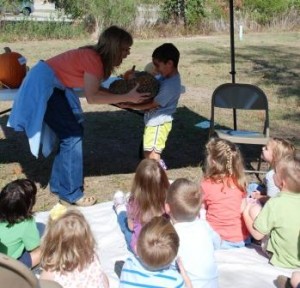
Charlie Brown: Oh brother. When are you going to stop believing in something that isn’t true?
Linus: When YOU stop believing in that fat guy in a red suit and the white beard who goes, “Ho, ho, ho!”




